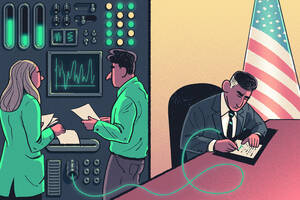Policy Feb 2, 2022
Psychological Factors—More Than Demographics—Drive Vaccine Behavior
The finding gives policymakers and medical professionals an important tool.

Michael Meier
We’ve been thinking about vaccination campaigns wrong.
That’s the conclusion of recent research from the Kellogg School that examined what factors predict whether someone will want to get vaccinated and whether they’ll follow through and actually do it.
With vaccine hesitancy contributing to record-high infection rates, there is increased urgency for this sort of information so that policymakers and healthcare practitioners can better understand what predicts vaccine behavior—and how to move the needle.
Most research and media stories have focused on demographic factors that influence vaccine intent and uptake such as race, education, and political affiliation. But Kellogg researchers Angela Lee and Ulf Bockenholt, both professors of marketing, along with Jiaqian Wang, a Kellogg doctoral student, took a different approach: they focused instead on psychological factors.
“We wanted a more psychological take on this decision, because there are, for sure, psychological factors that influence how people think and make decisions about vaccines,” Bockenholt says.
Lee, Wang, and Bockenholt, along with Leonard Lee at National University of Singapore, Rafal Ohme and Dorota Reykowska at NEUROHM, and Catherine Yeung at Chinese University of Hong Kong, conducted multiple studies to get at this question. Results from the U.S. suggest that they were right to focus on people’s beliefs and not just their demographics.
For example, Lee says, “Everybody talks about Republicans and Democrats as if they are completely different animals. But we found that those with more favorable perceptions of the vaccine—what we called ‘enthusiasts’—lean toward Democrat, but not fully, and there are Republicans in there. And vaccine ‘reluctants’ are mostly Republicans, but there are Democrats there, too.”
Overall, the research shows that “psychological factors are as much or more important than demographic variables related to vaccine intent and uptake,” Bockenholt says. “If you really want to understand people’s thinking, psychological factors are much more predictive.”
Understanding Vaccine-Related Behavior
The researchers began their study in April 2020—well before vaccines were available—by recruiting multiple waves of participants online to complete brief surveys about their willingness to be vaccinated. The research covered multiple countries, but the collaborators focused on the U.S. results, where they saw the most interesting patterns.
The team fielded six waves of surveys between April and December 2020, posing questions on psychological factors ranging from vulnerability (e.g., “My chance of getting COVID-19 is high”) to confidence (“I trust the government to administer the COVID vaccine”) to concern for others (“I would like to help people who are more vulnerable to COVID-19”), along with questions on compliance with COVID safety precautions (such as following CDC recommendations for mask-wearing) and about the fear of isolation during lockdown. They also asked about intent to be vaccinated once a vaccine was available.
The researchers conducted another survey in May 2021, after vaccines were widely available. This survey included the same questions from the 2020 questionnaires, along with additional questions about people’s current vaccination status, as well as what motivated them to get vaccinated if they’d done so. That survey revealed that 60 percent of respondents had received at least one vaccine dose, consistent with national rates at the time.
“The government has been saying, ‘you don’t want to get sick, so you better go get vaccinated.’ That doesn’t seem to move the needle at all.”
— Angela Lee
The researchers found that while demographic factors did predict vaccine behavior—for example, more-educated respondents expressed higher intent to be vaccinated—the models became significantly more predictive when psychological factors were considered. For example, compliance with CDC recommendations, trust in information reported in the media, and isolation anxiety were associated with higher vaccination intent.
Across both studies and other similar ones, the team identified different segments of people who behaved similarly with respect to vaccination intent and follow-through, and who also shared psychological factors.
For example, the researchers identified a segment they call “affluent receptives,” who have low financial concerns but are high in compliance and concern for others. Sixty-three percent of this segment expressed intent to be vaccinated before the vaccine was available, and 80 percent reported being vaccinated in the later survey. Another segment, “vigilant enthusiasts,” includes those who are high in perceived vulnerability, isolation anxiety, and concern for others. Within this group, 64 percent expressed intent to get vaccinated, and 70 percent in the later survey reported having received the vaccine. And within the “skpetical reluctants,” who are low in perceived vulnerability as well as trust in information, 24 percent expressed intent to get vaccinated, and 28 percent in the later survey reported being vaccinated.
“The psychological factors prove to be very important predictors of vaccination,” Bockenholt says.
And, Lee adds, “the good thing is that vaccine uptake was higher than intent across all segments.”
A Portfolio Messaging Strategy
The findings point to potential strategies for influencing vaccination rates by customizing messages to specific psychological profiles.
“Take isolation anxiety,” Lee says. “We know some people are anxious about being alone. And thinking about having to be alone due to the pandemic may make them more likely to get vaccinated. So the message to them is, ‘if you get vaccinated, you will be able to hang out with your friends.’ That’s a powerful message.”
Interestingly, the researchers found the psychological factor of vulnerability—or concern about one’s well-being—isn’t associated with vaccine intent or actual vaccination status. “The government has been saying, ‘you don’t want to get sick, so you better go get vaccinated,’” Lee says. “That doesn’t seem to move the needle at all.”
At the same time, those who chose not to be vaccinated, across segments, cited one main motivation above others for their inaction: concern about side effects. That poses a challenge for public-service messaging, as Lee notes: “It’s hard to overcome their worries about side effects. Maybe appealing to their fear of isolation or concern about others could cut through.”
In line with that thinking, those who fell into the “skeptical reluctant” segment were more likely to be motivated by concern for others. Here, Lee offers the example of her eight-year-old grandson: “When we took him for his first vaccine, he was screaming and kicking, and had to be held down. But when I later explained to him that we’re getting vaccinated to help those who can’t get the vaccine, like babies, he became more agreeable. ‘I’m going to do it for the babies,’ he said about the second shot.’”
Overall, the findings suggest the value of a portfolio approach to public service messages that matches message content to the psychological profile of the target group or individual.
The results also show how the relationship between a psychological factor and vaccine attitudes can change over time, especially post-vaccination.
For example, Lee points to participants who embraced the idea of compliance with CDC rules pre-vaccination. “People who endorse CDC compliance guidelines are more likely to say they will keep social distance, wash their hands, and get the vaccine. But once they get vaccinated, their interest in following safety measures declines. And we saw that those high in compliance are less likely to be vaccinated. This is the problem with the omicron variant—people feel because they’re vaccinated, they can go out and they stop wearing a mask. Then we see all the breakthrough cases.”
The researchers are making their data available to the public in hopes that others will dive into it to find more links between psychological factors and vaccine behavior. “There is certainly more information to be found that we didn’t uncover,” Bockenholt says.
But it’s clear from these results that messages on the importance of vaccinations need to be tailored to their audience. “Different segments respond to different things, based on their psychological profiles,” Lee says. “So you have to know who you’re talking to, to understand what will help.”
Sachin Waikar is a freelance writer based in Evanston, Illinois.
Lee, Angela Y., Jiaqian Wang, Ulf Böckenholt, Leonard Lee, Rafal Ohme, Dorota Reykowska, and Catherine Yeung. 2022. "The Enthusiasts and the Reluctants of COVID-19 Vaccine Uptake: A Cluster Analysis.” Journal of the Association for Consumer Research.



